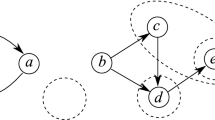Abstract
Some quantitative results obtained by proof mining take the form of Herbrand disjunctions that may depend on additional parameters. We attempt to elucidate this fact through an extension to first-order arithmetic of the proof of Herbrand’s theorem due to Gerhardy and Kohlenbach which uses the functional interpretation.
Similar content being viewed by others
References
Afshari, B., S. Hetzl, and G. E. Leigh, Herbrand’s theorem as higher order recursion, Annals of Pure and Applied Logic 171(6):102792, 2020.
Ferreira, F., The FAN principle and weak König’s lemma in herbrandized second-order arithmetic, Annals of Pure and Applied Logic 171(9):102843, 2020.
Ferreira, F., Weak König’s lemma in herbrandized classical second-order arithmetic, Portugaliae Mathematica 77,(3–4):399–408, 2020.
Ferreira, F., and G. Ferreira, A herbrandized functional interpretation of classical first-order logic, Archive for Mathematical Logic 56(5–6):523–539, 2017.
Gerhardy, P., and U. Kohlenbach, Extracting Herbrand disjunctions by functional interpretation, Archive for Mathematical Logic 44(5):633–644, 2005.
Gödel, K., Über eine bisher noch nicht benütze Erweiterung des finiten Standpunktes, Dialectica 12:280–287, 1958.
Kohlenbach, U., Herbrand’s theorem and extractive proof theory, SMF – Gazette des Mathématiciens 118:29–41, 2008.
Kohlenbach, U., Applied proof theory: Proof interpretations and their use in mathematics. Springer Monographs in Mathematics, Springer, 2008.
Kohlenbach, U., Proof-theoretic methods in nonlinear analysis. In: Sirakov, B., Ney de Souza, P., Viana, M., (eds.), Proceedings of the International Congress of Mathematicians 2018, vol. 2, World Scientific, 2019, pp. 61–82.
Kohlenbach, U., and L. Leuştean, Asymptotically nonexpansive mappings in uniformly convex hyperbolic spaces, Journal of the European Mathematical Society 12:71–92, 2010.
Kreisel, G., On the interpretation of non-finitist proofs, part I, The Journal Symbolic Logic 16:241–267, 1951.
Kreisel, G., On the interpretation of non-finitist proofs, part II: Interpretation of number theory, applications, The Journal of Symbolic Logic 17:43–58, 1952.
Parsons, C., On \(n\)-quantifier induction, The Journal of Symbolic Logic 37:466–482, 1972.
Shoenfield, J., Mathematical Logic, Addison-Wesley Publishing Co., 1967.
Streicher, T., and U. Kohlenbach, Shoenfield is Gödel after Krivine, Mathematical Logic Quarterly 53(2):176–179, 2007.
Tait, W. W., Infinitely long terms of transfinite type, in: J.N. Crossley, and M.A.E. Dummett, (eds.), Formal Systems and Recursive Functions, vol. 40 of Studies in Logic and the Foundations of Mathematics, Elsevier, Amsterdam, 1965, pp. 176–185.
Tao, T., Soft analysis, hard analysis, and the finite convergence principle; essay posted May 23, 2007; appeared in: Tao, T., Structure and Randomness: Pages from Year One of a Mathematical Blog, American Mathematical Society, 2008.
Tao, T., Norm convergence of multiple ergodic averages for commuting transformations, Ergodic Theory and Dynamical Systems 28:657–688, 2008.
Acknowledgements
I would like to thank Ulrich Kohlenbach for originally suggesting to me to look at the infinitary calculus which was introduced by Tait in [16], and for the continuing discussions I had with him on the topic. I would also like to thank Pedro Pinto for his suggestions. This work has been supported by a grant of the Romanian Ministry of Research, Innovation and Digitization, CNCS/CCCDI – UEFISCDI, project number PN-III-P1-1.1-PD-2019-0396, within PNCDI III.
Author information
Authors and Affiliations
Corresponding author
Additional information
Publisher's Note
Springer Nature remains neutral with regard to jurisdictional claims in published maps and institutional affiliations.
Presented by Daniele Mundici; Received November 25, 2021.
Rights and permissions
About this article
Cite this article
Sipoş, A. On Extracting Variable Herbrand Disjunctions. Stud Logica 110, 1115–1134 (2022). https://doi.org/10.1007/s11225-022-09990-5
Received:
Accepted:
Published:
Issue Date:
DOI: https://doi.org/10.1007/s11225-022-09990-5




